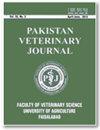求助PDF
{"title":"Isolation and Genetic Characterization of Staphylococcus haemolyticus from Cats","authors":"K. Bierowiec","doi":"10.29261/pakvetj/2020.033","DOIUrl":null,"url":null,"abstract":"Received: Revised: Accepted: Published online: November 12, 2019 January 03, 2020 January 15, 2020 April 07, 2020 Staphylococcus haemolyticus is widespread in humans and animals. The aim of this study was to characterize S. haemolyticus isolates from sick and healthy cats according to their antibiotic properties and biofilm formation. A total of 80 S. haemolyticus isolates from 36 healthy and 20 sick cats were investigated. All the isolates from the sick as well as from the healthy animals were multidrug resistant at the genetic level, whereas 82.5% showed phenotypic resistance. Almost all the isolates were methicillin-resistant S. haemolyticus (MRSH) at the genotypic and phenotypic levels of 98.75% and 96.25%, respectively. Moreover, the most frequently observed phenotypic resistances were those for erythromycin (87.5%) and penicillin (93.75%), and the isolates harboured genes involved in resistance to penicillin – blaZ (97.5%), aminoglycosides – aac(6’)Ie-aph(2”)Ia (92.5%), macrolide-lincosamide-streptogramin – ermB (98.75%) and ermC (72.5%), and tetracyclines – tet(K) (98.75%) and tet(M) (100%). The percentage of biofilmpositive strains in healthy and sick cats amounted to 92.68% and 97.44% for the microtiter plate test (P=0.4962) and 71.17% and 56.41% for the Congo red agar assay (P=0.5164), respectively. Statistically significant associations were observed when the owner’s occupation was connected with healthcare, both human or veterinary, there was previous hospitalization of the owner, or cats were kept with other animals in the household. MRSH strains isolated from companion animals were frequently multidrug resistant, although they remained susceptible to antibiotics used in mainly human medicine. ©2020 PVJ. All rights reserved","PeriodicalId":19845,"journal":{"name":"Pakistan Veterinary Journal","volume":null,"pages":null},"PeriodicalIF":3.8000,"publicationDate":"2020-01-01","publicationTypes":"Journal Article","fieldsOfStudy":null,"isOpenAccess":false,"openAccessPdf":"","citationCount":"3","resultStr":null,"platform":"Semanticscholar","paperid":null,"PeriodicalName":"Pakistan Veterinary Journal","FirstCategoryId":"97","ListUrlMain":"https://doi.org/10.29261/pakvetj/2020.033","RegionNum":3,"RegionCategory":"农林科学","ArticlePicture":[],"TitleCN":null,"AbstractTextCN":null,"PMCID":null,"EPubDate":"","PubModel":"","JCR":"Q1","JCRName":"VETERINARY SCIENCES","Score":null,"Total":0}
引用次数: 3
引用
批量引用
猫源溶血葡萄球菌的分离及遗传特性分析
2019年11月12日2020年1月03日2020年1月15日2020年4月07日溶血葡萄球菌广泛存在于人类和动物中。本研究的目的是根据其抗生素特性和生物膜的形成来表征从病猫和健康猫分离的溶血链球菌。从36只健康猫和20只病猫中分离出80株溶血链球菌。从患病动物和健康动物分离的菌株在遗传水平上均为多重耐药菌株,其中82.5%为表型耐药菌株。几乎所有分离株均为耐甲氧西林溶血链球菌(MRSH),基因型和表型水平分别为98.75%和96.25%。此外,最常见的表型耐药是红霉素(87.5%)和青霉素(93.75%),分离株含有青霉素- blaZ(97.5%),氨基糖苷- aac(6′)Ie-aph(2′)Ia(92.5%),大环内酯-lincosamide-链状gramin - ermB(98.75%)和ermC(72.5%),四环素- tet(K)(98.75%)和tet(M)(100%)耐药基因。健康猫和病猫生物膜阳性检出率分别为92.68%和97.44% (P=0.4962),刚果红琼脂试验检出率分别为71.17%和56.41% (P=0.5164)。当主人的职业与人类或兽医保健有关、主人以前曾住院治疗或猫与家中其他动物一起饲养时,观察到统计上显著的关联。从伴侣动物中分离出的MRSH菌株经常具有多重耐药性,尽管它们仍然对主要用于人类药物的抗生素敏感。©2020 PVJ。版权所有
本文章由计算机程序翻译,如有差异,请以英文原文为准。


